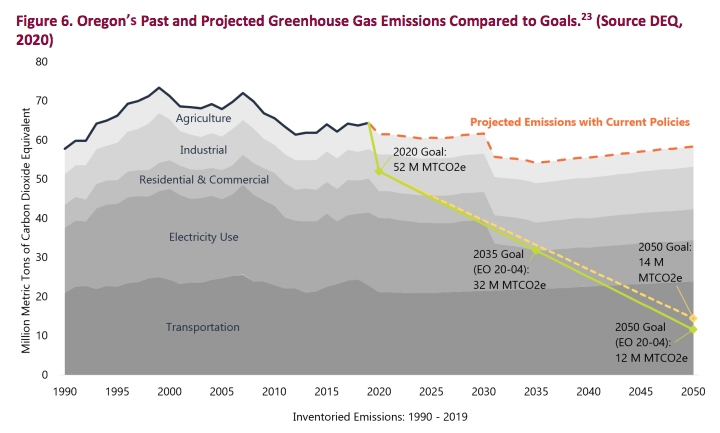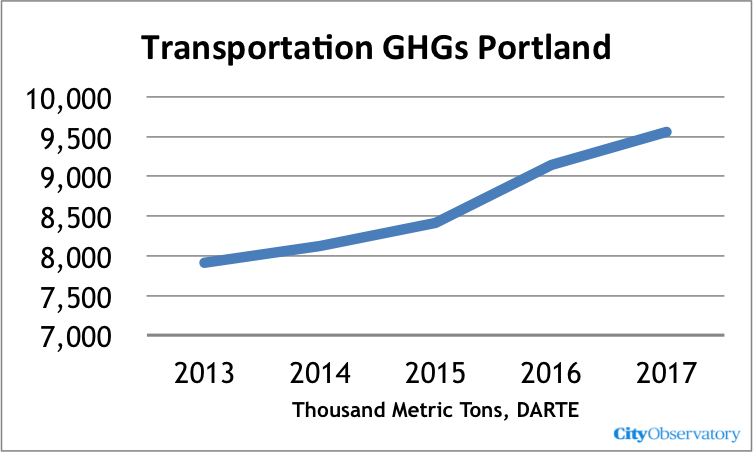Every year, the same story: We profess to care about climate change, but we’re driving more and transortation greenhouse gas emissions are rising rapidly.
Oregon is stuck in an endless loop of lofty rhetoric, distant goals, and zero actual progress
Case in point: Portland’s Regional Transportation Plan: It claims to do something about climate, but is ignoring the continuing increase in transportation GHGs and is planning to spend billions subsidizing more driving.
And Portland Metro is keeping two sets of books: one that pretends to meet climate goals, while another rationalizes increasing driving by 5 million miles a day.
Every February 2, City Observatory takes a moment to consider whether we’ve made any progress in our stated goal to do something about climate change. And once again, we find, like Bill Murray in the movie Groundhog Day, we’re stuck in an unchanging doom loop.

We’re coping with the climate crisis—and our failure to take it seriously—with a kind of second-order denial, not pretending that climate change isn’t real, but instead pretending that we’re actually doing something to solve it, or more precisely, pretending that the things that we are doing are not ineffectual.
Don’t Look Up: Failing to acknowledge that we’re losing ground on transportation GHGs
Oregon leaders are caught in the trap of yet another allegorical movie: “Don’t Look Up.” On paper, the region pledged a decade ago to implement a “Climate Smart Strategy” that would put the region on track to meet a state-adopted goal of reducing emissions by 80 percent from 1990 levels by 2050. As is true nationally, transportation, mostly driving, is the single largest source of greenhouse gases in Metro Portland. In the Portland area, per capita greenhouse gas emissions from transportation have increased more than 14 percent since 2013, by about 1,000 pounds per person. Total greenhouse gas emissions from transportation have increased by about 1.6 million tons per year over that time.
A “Climate Smart” Transportation Plan that Rationalizes More Driving
The Portland region is supposed to meet its climate goal through the implementation of its Regional Transportation Plan, which spells out how we’ll spend billions of dollars and hopefully reducing driving and car dependence. But there are glaring problems with the RTP: For starters, the Metro RTP simply fails to look to see whether greenhouse gases from transportation are declining, as the plan calls for. They aren’t: state, regional and federal inventories all show that despite nearly a decade of “climate smart” policies, Portland produces more transportation greenhouses gases now than before it implemented its strategy.
What’s worse, the adopted Regional Transportation Plan actually calls for policies and investments that will make greenhouse gas emissions worse. It proposes spending billions of dollars widening area freeways, something that will lead to more driving and greenhouse gases.
A close look at the technical analysis that is the foundation for the RTP shows that Metro has two completely different sets of “books” for assessing transportation. When it comes to demonstrating compliance with state climate laws and regulations, Metro has produced a set of projections showing we’ll hold total driving in the Portland area to its current level—in spite of increase population—by reducing per capita driving by almost a third. But when it comes to sizing the transportation system—and in particular—justifying investments in added highway capacity, Metro has a second set of books, that assume per capita driving doesn’t change at all, and that as a result, we end up driving about 5 million miles more per day in the Portland area than assumed the climate analysis. These two estimates are completely contradictory, and they mean that the Regional Transportation Plan doesn’t comply with state climate laws, and that if we actually followed through on our stated climate strategy of holding driving to its current level of about 20 million miles per day, we wouldn’t need to spend any more on expanding highway capacity. In reality, the greenhouse gas reductions promised by regional leaders only exist as hypothetical quantities in a separate appendix of the regional transportation plan, one that is divorced from actual spending plans, which contemplate spending billions on road widening.
Deja vu all over again’
If it seems to you like you’ve read this before, you have: The Oregon Global Warming Commission’s latest report reads like its predecessors. It chronicles the growing climate crisis, yet again declaring the state’s adopted goal to have lower carbon emissions by 2050, and presenting the data showing that we’re utterly failing to make meaningful progress. Here’s the key takeaway from the report: The yellow lines show the state’s stated goals, the dotted orange lines show the path we’re on. And if you look at the black (“actual”) line, you’ll see that emissions have actually increased since 2010. In short, in no way are we on track to meet our adopted goals.


